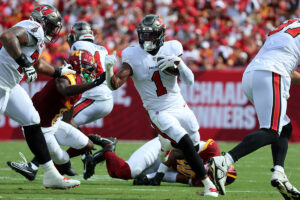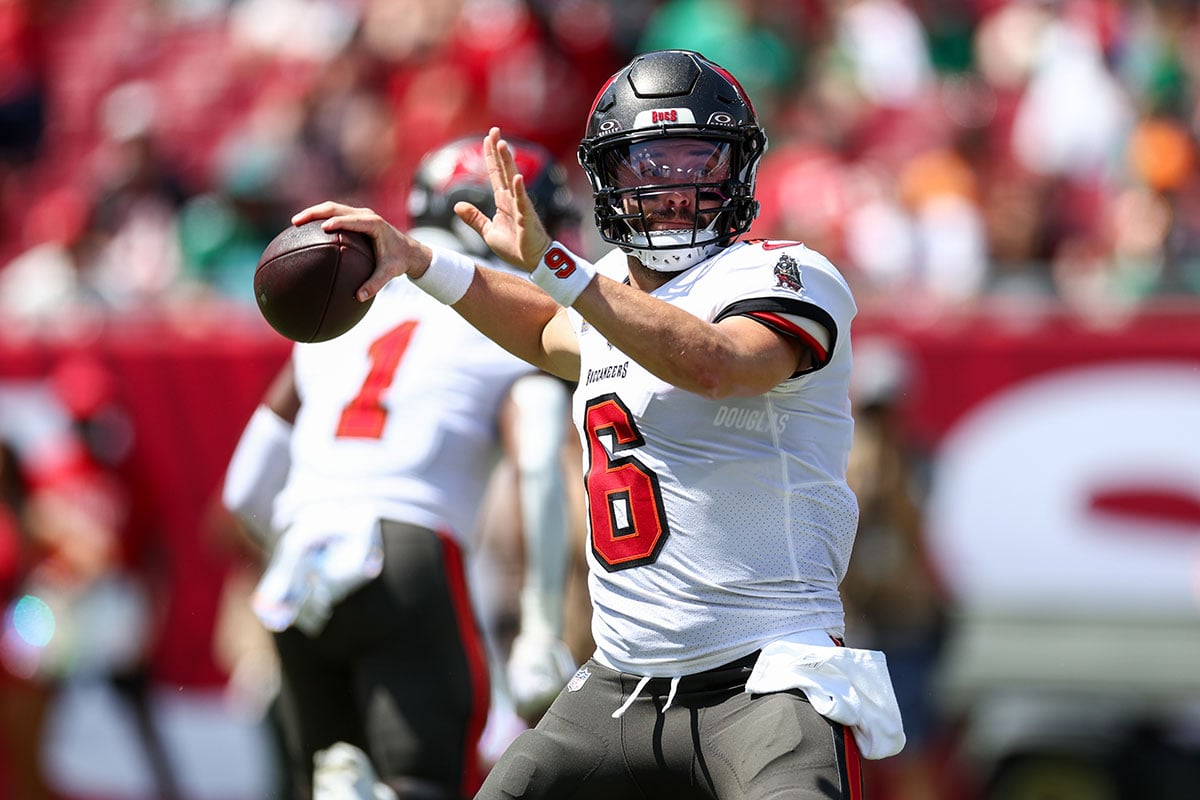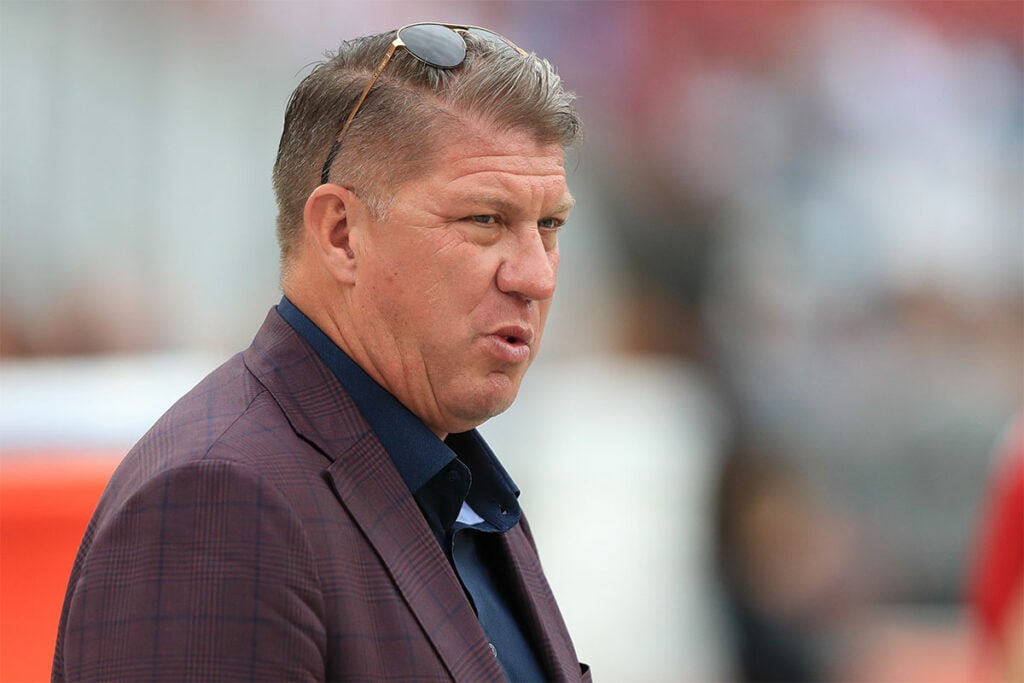To say the 2024 Bucs season has been a rollercoaster thus far would be quite the fair assessment. And they are only five games into the campaign. To date only one game has seemingly gone “to plan.” Tampa Bay’s Week 1 victory over the Washington Commanders did not rock the football world.
Since then, the Bucs have experienced highs and lows on a week-in, week-out basis that would give an EKG for a patient with tachycardia a run for it’s money. A surprising win in Detroit, followed by a flat performance against Denver. Then Tampa Bay rounded out their current 3-2 schedule with a resounding win over the Eagles before collapsing late against the Falcons.
The inconsistent nature of the team’s game-by-game results paired with the relative brevity of the season so far can lead to overreactions in terms of what is right, and wrong, with the current composition of the team as well as the near and long-term outlooks of each position group. So, with 30% of the regular season in the books I wanted to take a look at each position group through both a short and long-term lens while the Bucs try to get healthy on their mini bye following an emotional Thursday Night Football game.
Today we will look at the quarterbacks and running backs. Up next will be wide receivers and tight ends.
Quarterback
The Bucs signed Baker Mayfield to a three-year, $100 million contract this offseason in a move that was polarizing at the time. Through five weeks he is making general manager Jason Licht look like a genius. Mayfield is running new offensive coordinator Liam Coen’s system as if they have been working together their entire lives.

Bucs QB Baker Mayfield and OC Liam Coen – Photo by: USA Today
Mayfield is currently on pace to throw for 4,000 yards and 37 touchdowns. In a depressed passing environment those are extremely impressive numbers and will make his $33.3 million APY contract look like a bargain. Looking at a few different measures of quarterback play to try and create a composite assessment of his play relative to his peers, Mayfield ranks third in overall grade from PFF, 12th in yards per attempt, and 10th in EPA/drop back.
Mayfield’s biggest struggle this year has been sporadic bouts with pressure. During the Bucs’ loss to Denver, Mayfield often created or exacerbated pressure by dropping his eyes and bailing from clean pockets. But he seemingly resolved that issue the following week and has played extremely clean football for four out of five games this year.
The Bucs offense has a median score of 30 points this season and they have hit or exceeded that specific point total in 60% of their games thus far. With a run game that has not hit its stride yet, it has been a Baker-led passing attack that has done the bulk of the heavy lifting.
Key Stat: 2.6%
That represents Baker Mayfield’s turnover-worthy play rate according to Pro Football Focus. Mayfield is putting the ball in harm’s way at the lowest rate of his career. It is also tied for the 11th-best mark in the NFL right now. One of the biggest knocks on Mayfield throughout his career has been his propensity to turn the ball over which has created a perceived ceiling to his game. If he can continue to be smart with the ball without losing his aggressive edge entirely, he could finally ascend into a consensus top 10 quarterback this season.
Short-Term And Long-Term Outlook
No changes are needed here. There is no quarterback controversy. Baker Mayfield’s play has been revelatory as he has even been mentioned in some early MVP conversations. With his current level of play the Bucs will be all too happy to pay his $30 million salary next year and setting the sides up for an early extension re-negotiation in 2026.
Backup Kyle Trask, a former second-round pick, is in a contract year, but could be re-signed to a cheap, one-year deal. Then he and Michael Pratt could compete for the No. 2 job next offseason.
Running Back

Bucs RB Rachaad White – Photo by: USA Today
Where there is no controversy at signal-caller, there is nothing BUT controversy at the running back position. A key fumble and relatively poor play from Bucky Irving in Week 5 paired with a 56-yard explosive run from Rachaad White has probably dampened the debate for at least a week, but the voices will come back in force soon enough as people look the surface-level yard per carry disparity between the two backs and assume Irving is the far-superior back.
I have tried to lay out the more nuanced case that the issue is with the scheme and not so much the backs and that continues to be just as true headed into week six as it was headed into Week 2 and Week 4.
1/14 A thread on Bucky v. Rachaad with proper context applied. First off it I want to acknowledge some of the people who have provided useful information to put their ypc numbers in context. Myself and @LedyardNFLDraft have discussed it on his Audibles and Analytics Podcast.
— Joshua Queipo (@josh_queipo) September 26, 2024
Both backs are solid, if unspectacular. Both backs have a role in an effective offense. White has speed in space and is a Top 5 receiving and pass protecting back in the NFL. His foot speed and long strides work against him in tight spaces, and he struggles to press the front side of wide zone runs. Irving has the quick, short-area quickness that let him thrive in chaos and has an internal compass and pinball like running style that let him consistently get more yards after contact than the average back.
Among running backs with at least 20 carries this season Irving ranks seventh in yards after contact per carry (3.68) and 10th in missed tackle forced rate (27.27%). White is above average in both metrics as well, ranking 16th in yards after contact per attempt (3.29) and 19th in missed tackle forced rate (21.57%).
Key Stat: 2.0
The Bucs have average 2.0 yards per carry on outside zone, sweep and stretch plays this year. Bucky Irving is averaging 2.5 yards per carry, while Rachaad White is averaging 1.8. But those runs comprise 36% of their total first and second down runs in neutral game situations. The good news? That rate is going down by the week. Both backs can be successful if the scheme caters to them and their offensive line’s strengths.
On gap and inside zone runs in those same situations the Bucs’ top two backs average 5.6 yards per carry with Irving averaging 5.8 and White averaging 5.3 yards per tote.
Short And Long-Term Outlooks

Bucs RB Bucky Irving – Photo by: USA Today
In the short term, things should remain fairly static in terms of usage. Rachaad White should still out-snap Bucky Irving because he is the better back on passing downs and the Bucs pass the ball 2/3 of the time. As far as carries, the two backs should continue to split the load relatively evenly with Irving maybe getting 55% of the true carries and White still seeing an inordinate amount of the targets in the passing attack.
The big area for change is play-calling and Liam Coen seems to see that himself. With each passing week you are seeing more gap and less outside zone to the team’s benefit.
In the long term, the two comprise a perfectly serviceable running duo, provided they are utilized in a gap scheme. White will be entering a contract year in 2025, and I don’t see any real need for the Bucs to prioritize the position in the offseason.
Josh Queipo joined the Pewter Report team in 2022, specializing in salary cap analysis and film study. In addition to his official role with the website and podcast, he has an unofficial role as the Pewter Report team’s beaming light of positivity and jokes. A staunch proponent of the forward pass, he is a father to two amazing children and loves sushi, brisket, steak and bacon, though the order changes depending on the day. He graduated from the University of South Florida in 2008 with a degree in finance.




